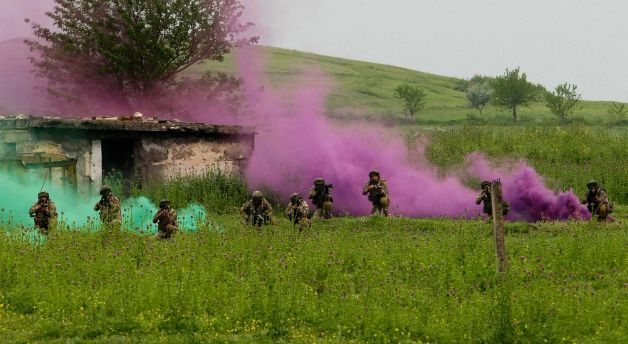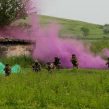
What Does the Arrival of American Military Equipment in Georgia Mean?
Publication: Eurasia Daily Monitor Volume: 12 Issue: 95
By:

On May 11, an unprecedented two-week military exercise, “Noble Partner 2015,” began at the former Russian military base, Vaziani, in the suburb of the Georgian capital of Tbilisi. Russia withdrew its last military forces from Vaziani in 2007 (Civil Georgia, May 11).
Georgian and United States military units have taken part in joint military exercises in the past, both on a bilateral and multilateral basis, particularly as part of the North Atlantic Treaty Organization’s (NATO) Partnership for Peace (PfP) program. But the latest exercises are unique for several reasons.
First, the US military brought heavy military equipment to Georgia for the first time—14 Bradley Tracked Armored Fighting Vehicles. The vehicles were brought into Georgia via the Georgian port city of Batumi, from Bulgaria (Agenda.ge, May 4, 2015).
Second, Noble Partner 2015 was the first joint exercise to prepare the Georgian military forces for participation in the NATO Response Force (NRF). Georgia officially joined the NRF in 2013, expressing its willingness to take part in any military operation of the North Atlantic Alliance (Dfwatch.net, October 10, 2013).
Third, holding such large-scale exercises on Georgian territory represents the first implementation of the “substantial package of cooperation” that Georgia received instead of a Membership Action Plan (MAP) at the NATO summit in Wales (CACI Analyst, September 17, 2014). Even though the government in Tbilisi regarded securing MAP as its first priority, the current activities within the “substantial package” have exceeded all expectations of the Georgian authorities.
And fourth, the large-scale US-Georgian military exercises are taking place in eastern Georgia, within 35 kilometers of the Russian military bases in occupied South Ossetia—at the moment when military and political tensions are still high in Ukraine. The risk of large-scale military actions resuming in eastern Ukraine remains high; while US military instructors train Ukrainian servicemen in western Ukraine (Rian.com.ua, February 24). Thus, the international context of Noble Partner 2015 further increases the importance of this exercise for Georgia and its neighbors and partners.
Georgian Prime Minister Irakli Garibashvili welcomed the US military personnel and stated that Georgia indeed would be a “Noble Partner” for the United States, as in Afghanistan, where Georgian forces had numbered 1,650 people and lost 29 soldiers and officers. The prime minister signaled that Georgia was prepared to fulfill its obligations within the framework of NRF operations (Kommersant, May 12, 2015).
The new minister of defense of Georgia, the Georgian Republican Party’s representative Tinatin Khidasheli, also welcomed the participants of the exercise. Khidasheli is considered one of the most pro-American politicians in the country (see EDM, May 6). She refused to respond to the question about whether the exercise would irritate Russia, telling the journalists “to avoid upsetting themselves with thoughts about what Moscow will or will not like.” In turn, Brigadier General Mark L. Loeben, the Director of Assessments and Analysis (ECJ7) at US European Command, stressed the importance of the joint training. Brig. Gen. Loeben pointedly emphasized that “the exercises are carried out on a former Soviet military base” (Kommersant, May 12, 2015). In fact, the Vaziani base is a likely candidate for hosting the Georgia-NATO “joint training center.” The deputy general secretary of the North Atlantic Alliance, Alexander Vershbow mentioned this in his statement during his last visit to Tbilisi at the beginning of the year (see EDM, February 4).
The Noble Partner 2015 exercise started with a landing by 1/91 CAV “Charley” Company’s paratroopers. Then, Georgia’s Khridoli instructors group showcased Georgian martial arts techniques (Mod.gov.ge, May 11).
Over the following days, about 600 US and Georgian servicemen held field trainings and a live-fire exercise. They carried out three phases of battalion-level training: theoretical preparation for Georgian military servicemen, live-fire training, and tactical maneuvers. Georgia was represented by “Alpha” Company of the 12th Battalion of the I Infantry Brigade, the I Mechanized Company of the 42nd Battalion of the IV Mechanized Brigade, as well as a Military Police Platoon. From the US side, a company of mechanized infantry and a company of marines participated in the exercises. Apart from the Bradley US infantry combat vehicles, several wheeled support vehicles were also used during this year’s Noble Partner (Mod.gov.ge, May 11).
The editor-in-chief of the military-analytical journal Arsenali, Irakli Aladashvili, told Jamestown, on May 15, that following the events in Ukraine, “the US raised the profile of [its] military exercises in the Baltic States and Georgia,” as clearly indicated by the act of bringing in Bradley infantry combat vehicles for the Noble Partner 2015 exercise. “Previously Americans never brought military equipment to Georgia,” Aladashvili said. According to the expert, Georgian military unit “Alpha” had been undergoing training for interoperability with NRF forces. Thus, it appears, the exercises that started in Vaziani on May 11 are actually only part of a larger program for improving the interoperability of Georgian and US military units. “It seems that in light of events in Ukraine, NATO decided to emphasize the NRF and to set up corresponding training centers in partner countries,” Aladashvili argued.
The Arsenali editor-in-chief also pointed out that the recent joint training focused on the interoperability of lightly armed units designed for close combat. Such units can be quickly dispatched over significant distances to carry out combat or peacekeeping operations. “Georgian units are prepared to stay on 24- or 48-hour alert, to be dispatched by airplanes or helicopters,” he said. According to the expert, the interoperability of the military operations has several dimensions and is developed through three to four stages. “Georgian officers learn how to plan military operations on the basis of reconnaissance, analyze information and make actual plans in cooperation with their US partners. Next comes the stage when the military learns how to be parachuted [into a theater],” Aladashvili explained.
The expert argued that the most distinctive feature of the Noble Partner 2015 exercise was not the usage of Bradleys, but a different set of skills the Georgian military was acquiring. In previous US-Georgian exercises, he noted, the Georgian military only learned how to set up check points, protect various objects, clear mines and screen people [coming through]—the types of activities carried out during peacekeeping operations. Now, the Georgian military is learning how to fight alongside US military forces. “This is very important, given the security risks that Georgia is facing,” Aladashvili concluded (Author’s interview, May 15).




